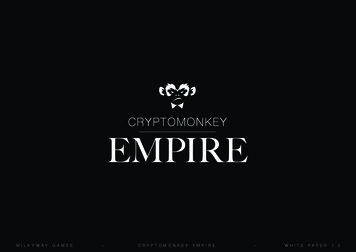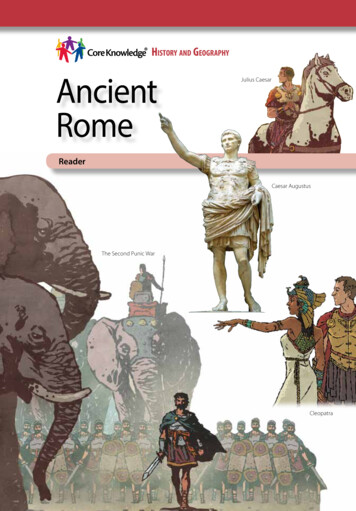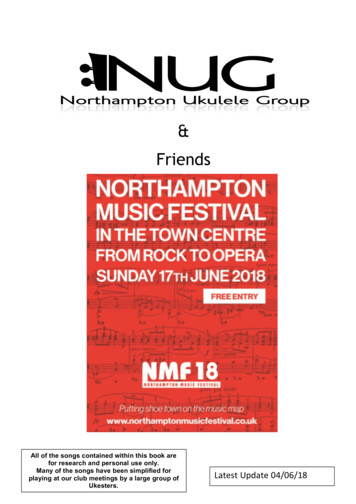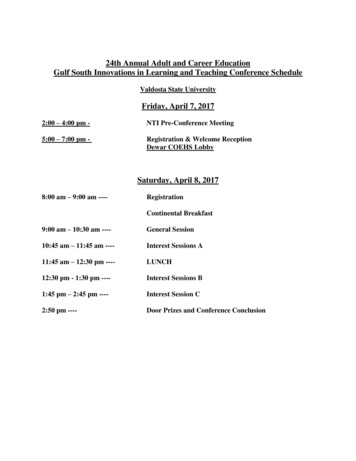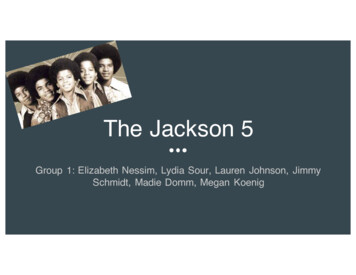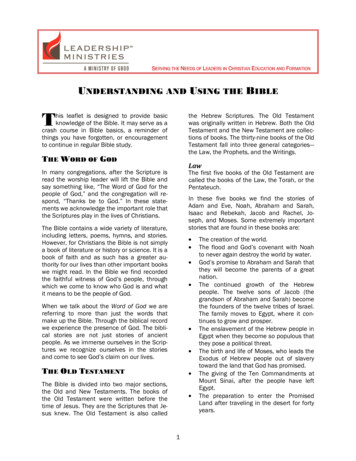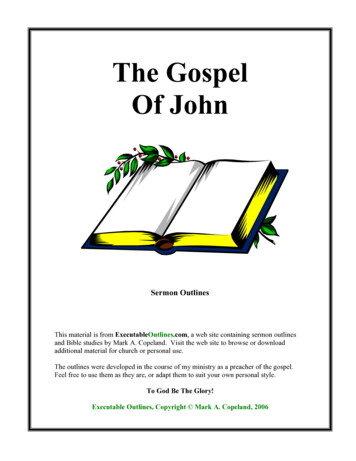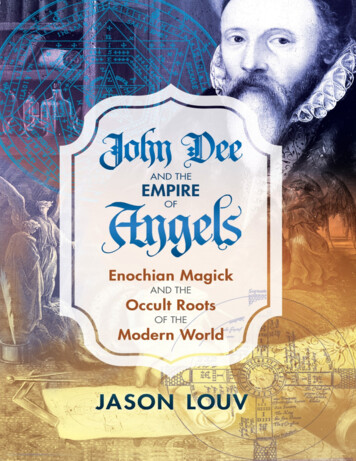
Transcription
For Devi
John DeeAND THEEMPIREOFAngels“Renaissance magus John Dee boldly set out to systematically tap themind of God by communicating directly with a complex hierarchy of‘angelic’ intelligences. It can be argued that he succeeded. His magicaldiaries have long held intense fascination among Qabalists, alchemists,and explorers of human consciousness who have developed workablemagical systems from these records. Jason Louv’s work succeeds, withbreathtaking thoroughness, to tell this amazing and true magical tale.More importantly, he also reveals the profound geopolitical significanceof Dee’s magical explorations—effects that still shape the globalrealities of today.”LON MILO DUQUETTE, AUTHOR OF ENOCHIAN VISION MAGICK“Jason Louv’s John Dee and the Empire of Angels is a groundbreakingnew assessment of one of the Western world’s most influentialpolymaths. Through a combination of intellectual rigor, sensitivity toboth historical and current sociopolitical climates, and perhaps a bit ofhis own intuitive scrying, Louv offers us a crystalline view of JohnDee’s visionary mind and complicated legacy.”PAM GROSSMAN, AUTHOR OF WHAT IS A WITCH AND HOST OF THE WITCHWAVE PODCAST“Jason Louv’s masterful account of the enigmatic Elizabethan magus
John Dee places him in the top tier of new esoteric writers. . . . Louv’sassertion of Dee as both a creator and custodian of Western civilizationis thought-provoking, and it is backed up by meticulous research. Highlyrecommended.”BRENDAN MCCARTHY, ARTIST, DESIGNER, AND COWRITER OF MAD MAX:FURY ROAD“The Dee story is among the most mystifying and important in the entirehistory of the Western esoteric tradition. And here, Jason Louv has givenus the most complete, complex, and balanced account yet of Dee and hisaftermath. An awesome achievement.”RALPH ABRAHAM, PROFESSOR EMERITUS OF MATHEMATICS, UNIVERSITYOF CALIFORNIA, SANTA CRUZ, CHAOS THEORIST, AND AUTHOR OF CHAOS,GAIA, EROS“Jason Louv’s book is absolutely invaluable. It contextualizes the verybedrock that Western ceremonial magic is based on. Dee and Kelly’slegendary experiments are the cornerstone of our Western understandingof how magic works. But there’s more to it than that. Louv’s impressivework is not only an enjoyable, adventurous journey into esoteric historybut also one into the multifaceted—and sometimes dangerous—machinations of the human mind.”CARL ABRAHAMSSON, AUTHOR OF OCCULTURE: THE UNSEEN FORCES THATDRIVE CULTURE FORWARD“Jason Louv weaves a masterfully poetic web that first introduces youand then sucks you into Dee’s luminous world of magick. This book isnot just a book about the occult and magick; it’s also a unique historicalreference guide that I found to be a hypnotic read. Jason is a brilliantmind and writer, and this book proves that.”ZACH LEARY, HOST OF THE MAPS AND IT’S ALL HAPPENING PODCASTS“Never has there been a more valuable and more prescient time thanNOW to have John Dee and the Empire of Angels published.”E. ELIAS MERHIGE, DIRECTOR OF BEGOTTEN AND SHADOW OF THE VAMPIRE
“This is the first book I’ve seen where Dee’s angelic magic is neitherdiscussed in isolation, nor dismissed as an eccentric sideline, butrecognized as a key part of Dee’s philosophy and political influenceright up to the present day.”LIONEL SNELL (A.K.A. RAMSEY DUKES), AUTHOR OF MY YEARS OF MAGICALTHINKING
AcknowledgmentsWriting a book is a lonely occupation that is only made possible by a network ofgood will, patience, and understanding.A great thank you to my girlfriend, Devi Brulé, whose love and patientsupport carried me day in and day out during the time I wrote this book. A thankyou as well to my parents, who encouraged me throughout its creation. Seriousthanks must also be reserved for my many students at Magick. Me, who made itfinancially possible for me to take the time off to write this book.Mark Frauenfelder of Boing Boing commissioned and published theoriginal article that became this book, and Jon Graham of Inner Traditionscommissioned the full work and was greatly supportive of its writing. Thank youas well to Jennie Marx and Manzanita Carpenter Sanz at Inner Traditions forhelping it into manifestation.Many people assisted along the way with encouragement, information, orby aiding in my research trips, including Daniel Andrew Nava, Dennis Woo,Alan Green, Adam Parfrey, Michael Le Tigre, Christie Casey-Young, Eli Lee, E.Elias Merhige, Detlev Auvermann, Thomas Negovan, Grant Morrison, Dr.Gregory DePies, and William Kiesel. Maria V. Montgomery and David RichardJones provided scans of the original Dee manuscripts and assisted withadditional information and context, particularly in regard to the chapter onAleister Crowley. Years prior to writing this book, Genesis Breyer P-Orridgeand Caleigh Fisher helped foster my interest in John Dee and the connection ofChristian eschatology to imperialism, and Lon Milo DuQuette’s books and liveseminars provided a handle on understanding Dee’s magic. Many people haveaided me in experimental research into Dee’s natural philosophy over the years;respect for personal privacy dictates that I must thank them as a whole.A final thanks to all of the Dee scholars and biographers on whose work Istand and whose research has proven invaluable to the present work, includingDame Frances Yates, Glen Parry, Benjamin Woolley, Nicholas Clulee, DeborahHarkness, György Szőnyi, Håkan Håkansson, and Stephen Skinner.
Veritas Praevalebit.
ContentsCover ImageTitle PageDedicationEpigraphAcknowledgmentsIn the GardenIntroduction: A Sublunary WorldENGLAND AT THE DAWN OF EMPIRETHE GREAT CHAIN OF BEINGREVELATIONTHE WESTERN MYSTERY TRADITION AND ESOTERIC PROTESTANTISMREADING DEETHE GUIDE FOR THE PERPLEXEDBOOK I: The MagusChapter 1: ElectedChapter 2: All as Study of AllChapter 3: The Light of the WorldChapter 4: The Elizabethan AscensionChapter 5: Ladder of Spheres
Chapter 6: Hammer of the WitchesChapter 7: A Cold War for a New WorldBOOK II: The Angelic ConversationsChapter 8: ContactEXPLANATORY THEORIES FOR THE SPIRIT ACTIONSDEE AND KELLY’S WORKING METHODSSANCTIFICATION AND ILLUMINATIONTHE SCRYING CRYSTALTHE TEMPLE FURNITURETHE ANGELIC LANGUAGESAY HELLO TO THE ANGELSTHE USE OF THE FURNITUREChapter 9: The Architecture of ApocalypseMYSTERIORUM LIBER PRIMUSMYSTERIORUM LIBER SECUNDUSMYSTERIORUM LIBER TERTIUSLIBER MYSTERIORUM QUARTUSLIBER MYSTERIORUM QUINTUSQUINTI LIBRI MYSTERIORUM APPENDIXChapter 10: And Therefore, Behold the EndRECORDSLIBER SEXTI MYSTERIORUM (ET SANCTI) PARALLELUSNOVALISQUE
Chapter 11: Aethyrs and WatchtowersLIBER PEREGRINATIONIS PRIMAE (SEXTI MYSTICIPARADROMUS)MENSIS MYSTICUS SAOBATICUS. PARS 1 AND 2LIBRI SEPTIMI, APERTORII, CRACOVIENSIS, MYSTICI,SABBATICI. PARS 3LIBRI SEPTIMI APERTORII CRACOVIENSISMYSTICI,SABBATICI. PARS 4LIBRI QUINTUS CRACOVIENSIS MYSTICUS APERTORIUS.PARS 5Chapter 12: On a Mission from GodMYSTERIORUM PRAGENSIUM CAESAREUSQUE. LIBERPRIMUSMYSTERIORUM PRAGENSIUM CONFIRMATIOMYSTERIORUM PRAGENSIUM CONFIRMATORUMMYSTERIORUM CRACOVIENSIUM STEPHANICORUMSTEPHANICA MYSTICA REGIAUNICA ACTIO; QUAE PUCCIANA VOCETUR. PARS PRIOR &POSTERIORLIBER RESURRECTIONIS,ET 42 MENSIUM FUNDAMENTUMChapter 13: I Am the Daughter of Fortitude,and Ravished Every HourMYSTERIORUM DIVINORUM MEMORABILIA. ACTIO TERTIAChapter 14: Gold Is the Metal with the BroadestShoulders
MORTLAKE AT THE END OF THE WORLDBOOK III: AntichristChapter 15: The Invisible CollegeChapter 16: Crowned and ConqueringTHE AEON OF HORUSTHE VISION AND THE VOICETHE BEAST 666CLEAN-UP IN AISLE NINETY-THREETHE AETHYRS THEMSELVESChapter 17: In the Shadow of the CrossPARSONS’S WORK WITH THE ANGELIC SYSTEMChapter 18: The Last JerusalemTHE INNER APOCALYPSETHE OUTER APOCALYPSEIT’S HAPPENINGAEON OF CHORONZONFootnotesEndnotesBibliographyAbout the AuthorAbout Inner Traditions Bear & Company
Books of Related InterestCopyright & PermissionsIndex
And the Lord God said, “The man has now become like one of us,knowing good and evil. He must not be allowed to reach out his handand take also from the Tree of Life and eat, and live forever.” So theLord God banished him from the Garden of Eden to work the groundfrom which he had been taken. After he drove the man out, he placed onthe east side of the Garden of Eden cherubim and a flaming swordflashing back and forth to guard the way to the Tree of Life.GENESIS 3:22–24 (NIV)The great secret known to Apollonius of Tyana, Paul of Tarsus, SimonMagus, Asklepios, Paracelsus, Boehme, and Bruno is that: we aremoving backward in time. The universe in fact is contracting into aunitary entity which is completing itself. Decay and disorder are seen byus in reverse, as increasing. These healers learned to move forward intime, which is retrograde to us.PHILIP K. DICK, VALIS
In the GardenBeginning it all: A man, a woman, and a Dragon.Around them, the Garden of Eden. A single, shining instance—before timebegan, with all its stupidity of suffering, loss, and waste. In which there is onlythe devotion of God for his Creation, and man and woman together, in love.Blissfully unaware, Adam and Eve sleep sheltered in each other’s armsbeneath the Tree of Life. They speak with the language of angels, and with it,Adam begins to name the things around him. Imagine yourself as Adam, namingall that you see, watching as each facet of eternity comes into being as a separateobject, divided from the supernal totality that is the body of God.And then, into this perfection, comes the Dragon. The snake of fear. Eat ofthe Tree of Knowledge, says the Dragon, and you shall taste all that God hashidden from you. Look into its eyes. See it twisting and coruscating in threehundred and thirty-three colors. The afterbirth of God’s Creation. The crack inthe plan. How must evil itself have appeared to such pure and innocent beings,the original parents of humanity, before the Fall? See it dancing, a serpent oflight.Listen to the wind howling through the rainforest as the Dragon coils uptoward the fruit of the Tree of the Knowledge of Good and Evil, urging you totake it. Look. The apple is perfectly polished. At first you can see your face in itssurface but now your focus begins to blur. You look through it. Scrying.Observe, now, the end of time. See the Red Dragon as it shall be, thedeceiver not just of the first humans but of the last, with seven crowned headsand ten horns, rearing up to conquer heaven itself. See its servants, a sevenheaded Beast upon which a Scarlet Whore rides, causing all humanity to worshipthe Dragon, as the nations decay and the human project collapses. The finaldegradation, in which the four cardinal directions are opened by Death, Famine,War, Conquest. See the last judgment, the son of God come to reign for aMillennium, when all but the saved are cast down to eternal torment in the lakeof fire. And all of this to redeem what you are about to do.
Now eat it, the Dragon says. Don’t you want to know what it is to be agod?
BOOK IThe Magus
7A Cold War for a New WorldAs of the twenty-first century, Drake’s Bay lies thirty miles northwest of thehyperreal technological mecca of San Francisco, California, a short drive acrossthe Golden Gate Bridge through the low, mist-covered hills and forest of MarinCounty. The bay stretches along eight miles of coast, and centers at Drake’sBeach, a small cove that looks out onto the Pacific, surrounded by sandstonehills and ice plant.Here, in 1579, a privateer named Francis Drake landed aftercircumnavigating the tip of South America in a clandestine mission, proving thatit could be done for the first time. He named the coast he had alighted uponNova Albion. The man who had masterminded Drake’s mission was John Dee.While Dee’s previous work had been theoretical, in the 1570s he involvedhimself in Elizabeth’s geopolitical planning, laying the ideological frameworkfor building a new world empire. This empire—which would spread the newideals of the Reformation and lead to the birth of America—would soon grow tocompete with the Spanish Catholic efforts at colonization. It was to be a coldwar for a New World.An omen of this war came seven years earlier, in 1572, when a new starappeared in the heavens, remaining visible night and day for seventeen months—we now designate it SN 1572, a Type Ia supernova that occurred in theconstellation Cassiopeia.1 Dee, who rushed to make observational measurementsof the supernova, thought that it confirmed that the final restoration of the world—the eschaton—was at hand.2 The astronomer, alchemist, and astrologer TychoBrahe, for whom the supernova is now named, believed that it was the first newstar to appear in the sky since the birth of Christ. Five years later, in 1577, agreat comet arrived above England, also observed by Brahe—confirming for thepopulace that the end of the world was nigh, fears upon which Dee was called toconsult by Elizabeth.3Indeed, it was the end of the world. By Dee’s time, Luther’s Reformation
had initiated sea changes in Europe that broke a centuries-long status quo.Inheriting a tiny and vulnerable country, Elizabeth had pursued a strategy ofavoiding war with the Catholic powers. To do so, she had kept France and Spainout of conflict by offering to increase support for whatever country wasthreatened by the other; both religion and Elizabeth’s own marital status weredrawn into this delicate political maneuvering. Yet the gambit could only last solong before war did break out, dragging England into the fray.4 Concurrently, theNetherlands had erupted into open revolt against the Roman Catholic KingPhilip II of Spain, which would result in the formation of the Protestant DutchRepublic by 1581.England was also economically insecure, besieged by desperation,homelessness, and plague. As England still grew its own food, it was vulnerableto famine if a wheat crop failed. Although the country’s food supply never ranout, famines would later make the 1580s and ’90s miserable for many, with thepoorest potentially resorting to eating bark and grass; French peasants from thesame time period are recorded as feeding on unripe grain, roots, and theintestines and blood left over from animals slaughtered for those that couldafford them.5 One of the primary reasons for England’s failing economy was themassive amount of silver that Spain was extracting from its New Worldcolonies, massively tipping the balance of economic power toward Spain. Bycontrast, England relied on textile exports, the manufacture of which had kept itspopulation employed, and Continental demand was now minimal, leaving muchof the country out of work. Trade with Russia, the Mediterranean, and Guineahad brought in some funds, but the real prize would be wresting at least partialcontrol of the New World from Spain.6
Fig. 7.1. Francis Drake. Portrait by Crispijn van de Passe the Elder, 1598.It is in this context that Dee gave the world the concept of a “BritishEmpire,” a phrase he coined. After Columbus’s discovery of the New World,Pope Alexander VI had divided the Americas between Portugal and Spain in the
Treaty of Tordesillas, handing them dominion over the Atlantic. Dee, with hisback pocket full of superior knowledge of geography, navigation, and optics,would soon suggest Elizabeth contest this, and expand into the New World notjust to rival Catholic domination, but for economic growth. Dee’s knowledge ofoptics, as well as the geographic and cartographic information he had absorbedunder Mercator and his other mentors, at a time when accurate cartographicinformation was largely confined to the Continent, made him invaluable in notonly conceptualizing but actualizing this plan. Yet for Dee himself, explorationof the New World had little to do with mercantile or even political goals. Hisfascination with imperialism pertained more to his occult calculations. It wasclear to Dee, if no one else, that America had been colonized by King Arthur—even that still-existing Arthurian colonies might be found in the NorthwestPassage. If this was the case, England had just as much spiritual claim toAmerica as Rome did.7The Muscovy Company, however, was already engaged in making realprofits from trading with the tsar in Russia, and wasn’t seeking to take furtherrisks on exploring west. Martin Frobisher got Elizabeth to lean on the company,and they in turn granted Frobisher a license with the proviso that he accept acompany man, Michael Lok, as his treasurer. Dee was brought in to minimizerisk by examining the plans for the voyage and imparting his knowledge ofgeometry, cosmography, and navigational instruments to the expedition leaders;Dee had spent fifteen years planning logistics for just such a voyage.8 Lokquickly warmed to Dee after realizing Dee wasn’t interested in competing withhim. Since Lok had outfitted the expedition with expensive new navigationaltechnology, he also had to make sure that Dee explained to his men how to use itwithout breaking it. Two ships were next commissioned—the Gabriel andMichael, named after the archangels that Dee would later record extensive trafficwith during the angelic conversations.Despite mishaps along the way, the Michael being forced back to port, andthe near loss of the Gabriel (it was only heroics by Frobisher himself that savedthe ship, nearly killing him) the voyage found land—the cyclopean ice walls ofwhat Frobisher called Meta Incognita, the Unknown Limit, which we now knowas Baffin Island in Canada. While exploring the coastline, Frobisher’s expeditioncame into conflict with Inuits, capturing and marooning one individual on arock. An exploratory mission of Frobisher’s men went missing shortly thereafter.After taking an Inuit as a hostage with a boat hook, Frobisher abandoned hopefor the return of his men and reversed course to England. The Inuit captivewould be recorded as an object of great wonder and fascination for the English,
before vanishing into the annals of history and a probably unpleasant fate.9Fig. 7.2. Later map of Meta Incognita by Sir Robert Dudley and Antonio FrancescoLucini, c. 1647.Even more interesting to the Crown was a sample of black ore thatFrobisher had found in Meta Incognita, and that English alchemists claimed to
have found gold in. For Dee, this discovery validated that the 1572 supernovaforetold the discovery of the philosopher’s stone. For the English government, itwas a galvanizing reason to return to Meta Incognita for more, under the coverof secrecy, to avoid claim jumping. Funding was no longer an issue—even thecash-poor Dee, seeing the potential for return, invested 25 (about 6,000 or 7,700 in 2017 terms).10A crew of 140 was raised, including several prisoners who were to againboard the Michael and Gabriel, along with a third ship entitled the Aid, and thento be left in the New World to try and win the “good will” of the locals, in muchthe same way that America and Australia would later be colonized. After sixweeks, the expedition reached what is now known as Frobisher’s Strait andmoored in what they named Jackman’s Sound, which Frobisher claimed forEngland in the country’s first act of colonial conquest of the New World. Settingout to search for more of the gold ore, the crew found nothing but a deadnarwhal, which they called a “sea unicorn.” Immediately thereafter, the sailorsfound more of the black ore, which they began loading into the ship, all whilefighting off violent attacks from the now-incensed Inuits.11In all, Frobisher hauled over 140 tons of the ore back to England,presenting news of his find to Elizabeth, along with the narwhal’s horn. The orewas put under lock, key, and security detail, and tests on it commenced,whereupon only minute quantities of gold and silver were extracted, toFrobisher’s dismay.12Despite the low yield of precious metals, a third voyage was sent back toCanada to claim what profits could still be salvaged. The crew returned with1,150 tons, but by this time Lok’s Cathay Company was severely over budget; asa result of the expeditions, Lok declared bankruptcy and was thrown intodebtor’s prison. After countless salvage attempts, the final extracted yield fromthe black ore was one single pinhead of silver.13To Dee, however, the political value of the English voyages toNewfoundland and Baffin Island was immense—and not only because they weregathering data in the search for the Northwest Passage.14 In November 1577,Dee presented a new imperial plan to Elizabeth, suggesting that England wrestcontrol of the New World from Spain—General and Rare Memorials, a set ofdocuments laying out plans and technical guidelines for a new era of Englishcolonization.The Memorials continued the occult inquiry Dee began in thePropaedeumata aphoristica and Monas hieroglyphica; as with those books, Dee
thought the Memorials divinely inspired (also by the angel Michael, in the caseof the Monas). For Dee, the Memorials were a revelation from the angels, divineguidance on the creating of a British Empire, through a Royal Navy that wouldhold the world in its sway.15In the text, Dee argued that Britain had the greatest need of any country fora continually operational navy, and that it also had the world’s greatest supply oftimber, shipbuilders, willing volunteers for shipyard labor and staffing ships, andeven suitable harbors. Establishing such a navy would make Britain nigh-oninvincible (it did), and expansion of the British Navy and colonization of theNew World not only had historical precedent but would surely raise vast richesfor the Crown (it did).16 Such a plan would establish Elizabeth as the world rulerbefore the end times arrived; the money raised for the naval effort, Dee lateradded, could also be used to help build a new alchemical institute to produce thephilosopher’s stone—the final perfection of which would reestablish the empirein full.17 In his partially lost 1577 manuscript “Famous and Rich Discoveries,”Dee speaks of how he would ascend above the heavens, to look down upon theearth and divine the Northwest Passage.The cover of the Memorials depicts Elizabeth helming a ship representingBritish imperialism, with the angel Michael flying before her with sword andshield in hand and the Tetragrammaton above her, the ship being drawn forth by“Lady Occasion” toward freshly conquered territories. Following this are severalpages rebuking Dee’s reputation as a sorcerer—Murphyn and Prestall’s attackshad been so successful that Dee was forced to address their slander upfront.The four volumes of Dee’s imperial magnum opus were as follows:1. General and Rare Memorials, completed and still extant. This addressedraising funds for and constructing a Petty Navy Royal of sixty 120-ton to200-ton “tall ships” and twenty small warships weighing between twentyand fifty tons each, staffed by 6,600 well-paid men, the funds to be raisedthrough taxation, as the wealth gained by imperial expansion would trickledown to the English people. This navy, Dee thought, would be the “MasterKey” that would solidify English dominance, a “war machine”*10 to guardEngland against its enemies. Although Dee was not originally concernedwith state affairs, court politics would later force Dee to rewrite theMemorials to encourage the support of Holland and Zealand. Thecombination of the Dutch and English militaries would solidify control overthe Narrow Seas in the wake of Spain’s withdrawal from the Low
Countries. Also disgusted by the state of the Thames (upon which Mortlakewas situated), Dee added an ecological broadside against the improper useof nets to fish the river.18Fig. 7.3. Cover of Dee’s General and Rare Memorials, 1577.
2. A set of navigational tables, calculated using Dee’s paradoxical compass,which would have been larger than the English Bible. This was unpublishedand is presumed lost. (Dee’s paradoxical compass could have been usedalong with these tables to keep navigation precise; unfortunately, the newlydrafted sailors found it too complex, and resisted training in its use.)193. A volume so secret that Dee stated it “should be utterly suppressed ordelivered to Vulcan’s custody” (i.e., burned).20 Also lost, this manuscriptmay well have dealt with angelic magic or other occult or astrologicalcalculations relating to imperial expansion. It may also have had to do withRome or the Spanish, which would have necessitated even greater secrecythan occult material.4. Of Famous and Rich Discoveries, which survived, albeit in a partly firedestroyed form. Here Dee set forth the case for English expansion andterritorial claims, and suggested exploratory voyages.21Following the exploration of Newfoundland, Dee became concerned withdiscovering if America was a separate continent from Asia. Abraham Orteliushad suggested that a “Strait of Anian” connected the Northwest Passage to thePacific; however, North America was suspected to be so large that anybody whotried to discover this passage by entering Newfoundland where Frobisher hadand continuing to sail west would run out of supplies and freeze to death longbefore hitting the Pacific. Yet if one were to sail south, rounding the tip of SouthAmerica, conditions would be far more favorable to continued sailing, and anexpedition could look for the outlet of the Northwest Passage on the other side ofNorth America. In the pages of Of Famous and Rich Discoveries, Dee made acompelling case that England should do exactly that.22To undertake this perilous voyage, Dee and Elizabeth looked to an unlikelycandidate: the privateer and slave trader Francis Drake. Drake undertook themission between 1577 and 1580, taking a fleet of six ships, including his ownPelican. The voyage was beset by storms, loss of personnel, mutiny, and ship rot—by the time Drake reached the Pacific, only the Pelican remained, which herechristened the Golden Hind. Drake proceeded up the coast of South America,attacking Spanish settlements and capturing ships as he went, looting treasure,wine, and maps in the process. Had Drake been commanding an official Englishfleet, this would have been an act of war, but his privateer status lent Englandplausible deniability, making Drake’s raids a form of naval black ops. In June1579, he landed at what is now called Drake’s Bay, north of San Francisco,
before reversing course, and returning to England by way of the Cape of GoodHope and the Sierra Leone. Upon his arrival, the logs of the expedition, andtherefore the route Drake had discovered, were immediately ordered classified.23Drake returned to England a celebrity, and was knighted soon thereafter.As soon as Drake returned, plans for another voyage began to coalesce. InSeptember 1580, Humphrey Gilbert and Dee drew up a plan that, should Gilbertgain control of the northern New World, Dee would receive everything abovethe fiftieth parallel—granting him Alaska and the majority of Canada.24 Twoyears later, Dee still suspected that a Northwest Passage existed across the top ofNorth America, and drew a map for Gilbert depicting it, in which he placed theWest Coast of North America only 140 degrees west of England.25Meanwhile, on February 5, 1578, Dee had married Jane Fromoundes.Supported by Elizabeth, he had proposed only a few months after the death ofhis first wife, Kathryn Constable, in March 1575. Jane was a member of court, agentlewoman servant to Lady Katherine Howard, Elizabeth’s best friend.Fromoundes’s Catholic family hardly approved of the “arch-conjuror”; herfather, Bartholomew Fromoundes, died of a stroke the day after John and JaneDee’s son Arthur was born.26 Dee may have had one eye on securing a betterposition for himself by marrying into court. Unfortunately, to Dee’s lifelongdisadvantage, there was no patronage for scientists during Elizabeth’s reign—unlike the Continent—explaining Dee’s quest for patronage abroad. The bestDee could hope for in England was an academic or Church position, and eventhese he was regularly frustrated in attaining.27In the meantime, sectarian conflict was only intensifying. Over theprevious decade, the Protestant Low Countries had exploded into open revoltagainst Spain’s Catholic rule, which would soon result in the formation of anindependent Dutch Republic, and suggest strategic alliances with England. Thisadded to the backdrop of war between the Protestant and Catholic spheres. Deewas soon called upon to defend Elizabeth from Catholic magical attack yetagain, when wax images of Elizabeth and members of the Privy Council werediscovered in a dunghill—as the dunghill melted the wax, by the logic ofsympathetic magic, so would Elizabeth and her council come to harm.Though the Council was as alarmed by Dee’s countermagic as they wereby the original sorceric attack, Dee found himself well positioned: Dudleyneeded him to dig up as much evidence as possible on Catholic magical attacks,as this would assist Dudley against his Catholic rivals at court. Those capturedthanks to Dee’s detections were held and tortured.28 Among those arrested on
Dee’s cue was John Prestall, who was tied to a suspected Catholic conspiracy tomagically attack the queen. Elizabeth was indeed ailing, but the cause wasprobably poor dental hygiene, not the occult. Prestall—whom Dee may have hadarrested at least partially out of desire for revenge—was tortured for over amonth, but no information on any conspiracy was forthcoming. The Councilsubsequently fetched Prestall’s cosaboteur Vincent Murphyn for interrogation.29While Dee was sent to seek a cure for Elizabeth’s ailment from theGerman alchemist Leonhard Thurneysser, Dudley whipped up a propaganda waragainst Catholic sorcery, which could be lurking around any corner. But Dee andDudley’s occult pogrom collapsed when it was revealed that the magicianThomas Elkes had made the wax dolls as part of a love spell for a client. Deewas revealed to have been wrong the entire time.30After long decades of theoretical work, Dee was now turning his attentionto actual operative magic—he had embarked on a series of alchemicale
LON MILO DUQUETTE, AUTHOR OF ENOCHIAN VISION MAGICK “Jason Louv’s John Dee and the Empire of Angels is a groundbreaking new assessment of one of the Western world’s most influential polymaths. Through a combination of intellectual rigor, sensitivity to both historical


